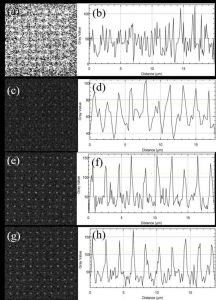R&D: Chinese Scientists Explore New Material for Optical Storage
TPE material could be used in ODS and explores new potential application in dual-beam super-resolution optical storage in future.
This is a Press Release edited by StorageNewsletter.com on March 25, 2020 at 2:23 pmBy Li Yuan, Chinese Academy of Sciences
Approach demonstrates that TPE material could be used in ODS ( Optical Data Storage) and explores new potential application in dual-beam super-resolution optical storage in future.
Fluorescence maps with different Zn2+ weight percentages.
(image by SIOM)
Click to enlarge

Since the aggregation-induced emission (AIE) material was found in 2001, different kinds of AIE materials have been developed. However, their main applications are only in optoelectrical devices, chemosensors, and biological applications.
Recently, researchers from the Shanghai Institute of Optics and Fine Mechanics (SIOM) of the Chinese Academy of Sciences and Huazhong University of Science and Technology revealed a novel channel to achieve optical data storage (ODS). The finding was published in Applied Optics.
Using Tetraphenylethene (TPE)-doped photopolymer matrix, a kind of AIE material, the researchers conducted the fluorescence enhancement process in two steps.
They fabricated the liquid photopolymer matrix that did not contain Zn2+ and solified the photopolymer matrix using hand-held Uv-light. Then, they recorded binary data points inside the storage medium using two-photon absorption effect. The signals were barely distinguished because they were completely overwhelmed by the background noise.
In order to improve the signal contrast, they blended different Zn2+ weight percentages into the storage medium and fabricated solid film using the same method. They found that the Zn2+ reacted with TPE dye could increase the TPE-conjugated degree under the effect of femtosecond laser light.
Through a series of experiments, they chose 6.2 wt% Zn2+ as the best weight percentage and obtained good signal contrast. Thus, this medium is suitable for ODS application.
This approach demonstrates that TPE material could be used in ODS and explores the new potential application in dual-beam super-resolution optical storage in the future.
Article: Zn2+ responsive fluorescence enhancement for optical data storage
Applied Optics has published an article written by Xupeng Yuan, Miao Zhao, Laboratory of Micro-Nano Optoelectronic Materials and Devices, Shanghai Institute of Optics and Fine Mechanics, Chinese Academy of Sciences, No. 390 Qinghe Road, Jiading District, Shanghai 201800, China, and Center of Materials Science and Optoelectronics Engineering, University of Chinese Academy of Sciences, No. 19 Yuquan Road, Shijingshan District, Beijing 100049, China, Xinjun Guo, Laboratory of Micro-Nano Optoelectronic Materials and Devices, Shanghai Institute of Optics and Fine Mechanics, Chinese Academy of Sciences, No. 390 Qinghe Road, Jiading District, Shanghai 201800, China, Yao Li, National Center for Protein Science Shanghai, No. 333 Haike Road, Pudong New District, Shanghai 200120, China, Zongsong Gan, Wuhan National Laboratory for Optoelectronics, Huazhong University of Science and Technology, No. 1037 Luoyu Road, Hongshan District, Wuhan 430074, China, and Shenzhen Huazhong University of Science and Technology, and Hao Ruan, Laboratory of Micro-Nano Optoelectronic Materials and Devices, Shanghai Institute of Optics and Fine Mechanics, Chinese Academy of Sciences, No. 390 Qinghe Road, Jiading District, Shanghai 201800, China.
Abstract: “In this paper, we put forward a new application in optical data storage (ODS) of tetraphenylethene (TPE)-doped photopolymer, which has an aggregation-induced emission attribute. The photopolymer host reacted with the excitation light at the focal point of a high numerical-aperture lens to enhance the fluorescence intensity mainly because of the function of the ${{\rm Zn}^{2 + }}$ ion. We recorded data inside the photopolymer matrix by using this property and had distinct fluorescence intensity contrast between the photochemical regions and other regions. This attribute paves a new way for superresolution ODS and opens the way to exploring the possibility of utilizing TPE-doped photopolymers as chemical sensors in the future.“













 Subscribe to our free daily newsletter
Subscribe to our free daily newsletter

